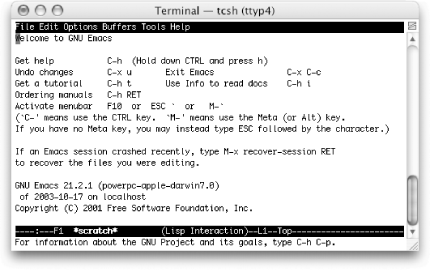Emacs and Mac OS X
As you may have picked up reading other parts of this book, we treat Mac OS X as a Unix variant for many tasks. We do that with good reason, of course. Mac OS X is based on Unix. For example, you could more or less follow the CVS and Unix build instructions in the previous sections and come away with a full installation of Emacs.[3] However, as you know, Mac OS X can be a little different in some ways; it doesn't have all the Unix utilities by default (see the section on installing Ispell for one example of this). This section covers installing Emacs on Mac OS X as well as other issues such as running Emacs from the command line, changing the location of your Meta key, and installing Ispell. And if you do want to build Emacs from scratch using CVS, we have a few notes on that, too.
"But I Already Have Emacs"
Mac OS X comes with a version of Emacs installed: 21.2.1 with Panther (10.3.2) and 21.1.1 with Jaguar (10.2.8). To start this version, use the Terminal application in your Utilities folder (which is inside the Applications folder) and just type emacs.
Figure 13-3 shows the built-in Emacs running in the Terminal application.

Figure 13-3. The Terminal-based Emacs built into Mac OS X
But you should be aware that although it is built-in and certainly the easiest to start using, this version of Emacs has a few shortcomings:
It runs, well, you know, in a Terminal.
Get Learning GNU Emacs, 3rd Edition now with the O’Reilly learning platform.
O’Reilly members experience books, live events, courses curated by job role, and more from O’Reilly and nearly 200 top publishers.

